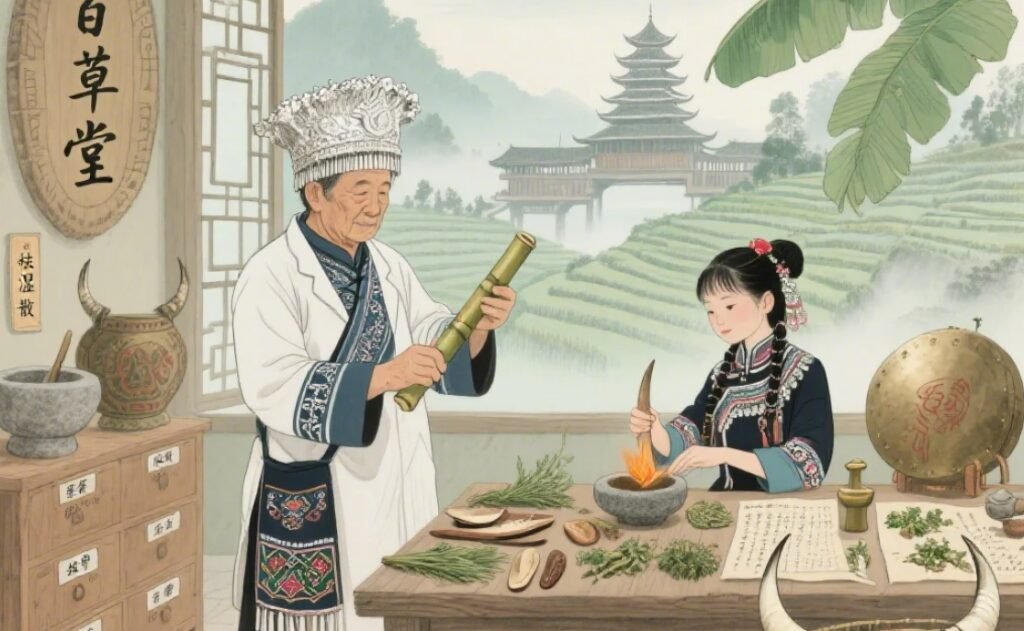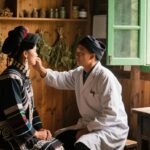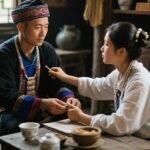[Overview] In Miao medicine, diabetes is known as Ghangb lo1, also called Ke wo lo or Xinxin da. The name Ghangb lo1 literally refers to the phenomenon where a patient’s urine attracts ants when excreted on the ground—hence the colloquial terms “ant disease” or “sweet urine.”
In Traditional Chinese Medicine, diabetes (Xiao Ke) is characterized by excessive thirst (polydipsia), excessive hunger (polyphagia), excessive urination (polyuria), emaciation, and fatigue. Sweet or turbid urine is also a hallmark. The Huangdi Neijing refers to it as the “Three Consumptions”: Upper Consumption (thirst with voracious thirst), Middle Consumption (hunger after drinking), and Lower Consumption (urination immediately after drinking).
In Western medicine, diabetes mellitus comprises metabolic disorders marked by chronic hyperglycemia resulting from defects in insulin secretion, insulin action, or both. Long-standing hyperglycemia can cause progressive damage to tissues, particularly in the eyes, kidneys, heart, blood vessels, and nerves.
[Symptoms in Miao Medicine] Ghangb lo1 is considered a minor syndrome and is divided into two patterns: Cold-Meridian Diabetes and Hot-Meridian Diabetes.
[Etiology] Miao theory attributes Ghangb lo1 to irregular diet, congenital weakness, and age-related decline in vitality.
[Pathogenesis] External pathogenic factors injure both qi and body fluids. As the saying goes, “Injury to qi damages blood; injury to blood damages qi.” When qi and fluids are deficient, water metabolism fails. This leads to the classic manifestations of excessive thirst, hunger, urination, fatigue, and emaciation.

[Diagnosis]
Diagnostic Criteria:
Clinical features of polydipsia, polyphagia, polyuria, emaciation, or sweet-tasting urine are diagnostic. Onset is most common in middle-aged or older adults with a history of rich, fatty foods or heavy alcohol use. Early-onset in youth often indicates more severe disease.
In early stages, the “Three Excesses” may be inconspicuous. Chronic cases can complicate with dizziness, pulmonary consumption, chest pain, stroke, night blindness, or ulcerations—accompanied by thirst, headache, vomiting, abdominal pain, dyspnea, and even coma.
A family history of Ghangb lo1 suggests a genetic predisposition.
Laboratory Tests:
Fasting and 2-hour postprandial blood glucose, urine glucose and specific gravity, and oral glucose tolerance tests aid in diagnosis. Kidney function panels, serum electrolytes, and CO₂ combining power may also be indicated.
[Differential Diagnosis] Diongxeb wal·ed nul (LIN Syndrome):
Presents with frequent, urgent urination, dripping post-void, urethral burning, lower abdominal spasm, and lumbago. No polyphagia, polydipsia, sweet urine, or weight loss. Urine glucose is negative and blood glucose is normal.
[Syndrome Classification and Treatment] Clinical Manifestations: Polydipsia, polyphagia, polyuria, profuse sweating, marked weight loss, and sudden increase in appetite; urine is abundant and sweet. Meridian Pattern: A mixed pattern of heat and cold—early stages manifest as a hot-meridian syndrome, while late stages transition to cold-meridian syndrome. Treatment Principles: Clear stomach heat and relieve thirst (qing wei zhi ke); clear heat and relieve thirst via cooling (qing re zhi ke).
Early Stage — Hot-Meridian Diabetes: Formula & Explanation:
Puerariae Radix (Gegen) 12 g: Cold, sweet; generates fluids, alleviates thirst, releases the exterior, and reduces heat.
Schisandrae Fructus (Wuweizi) 12 g: Warm, sour-bitter; astringes lung qi, tonifies yin, and calms the spirit.
Dendrobii Herba (Shihu) 10 g: Slightly cold, sweet; nourishes yin, clears heat, and generates fluids.
Platycladi Semen (Liangfencha) 15 g: Cold, bland; clears heat and resolves dampness. Decoction, taken orally.
Late Stage — Cold-Meridian Diabetes: Formula & Explanation:
Polygonati Rhizoma (Huangjing) 20 g: Neutral, sweet; tonifies qi and yin, strengthens the spleen, and moistens the lungs.
Mori Fructus (Sangshen) 20 g: Warm, sweet; nourishes yin and blood, benefits liver and kidney, and generates fluids.
Polygoni Multiflori Radix (Heshouwu) 20 g: Warm, sweet‑astringent; nourishes essence and blood, and fortifies liver and kidney. Decoction, taken orally.
[Preventive Care] Beyond pharmacotherapy, lifestyle regulation is crucial:
Limit refined grains, fats, and sugars; prioritize whole grains, vegetables, legumes, lean meats, and eggs; eat at regular intervals and in moderation.
Abstain from tobacco, alcohol, strong teas, and coffee.
Maintain a balanced mood, regular sleep-wake cycles, and moderate exercise.
[Commentary] Miao medicine views disease as resulting from both internal injury and external factors. Ghangb lo1 arises from congenital weakness, age-related decline, dietary excess, or pathogenic invasion damaging qi and body fluids. As the proverb states, “Water generates blood, and blood carries water; without water, blood cannot be born; without blood, water cannot nourish.” When qi and fluids are disrupted, disease ensues. The dual injury to qi and blood leads to dysfunction manifesting as polydipsia, polyphagia, polyuria, fatigue, and emaciation. Treatment focuses on clearing stomach heat and relieving thirst.


Leave a Reply